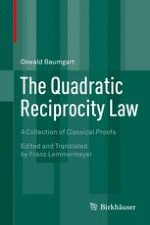
2015 | OriginalPaper | Buchkapitel
1. From Fermat to Legendre
verfasst von : Oswald Baumgart
Erschienen in: The Quadratic Reciprocity Law
Aktivieren Sie unsere intelligente Suche, um passende Fachinhalte oder Patente zu finden.
Wählen Sie Textabschnitte aus um mit Künstlicher Intelligenz passenden Patente zu finden. powered by
Markieren Sie Textabschnitte, um KI-gestützt weitere passende Inhalte zu finden. powered by